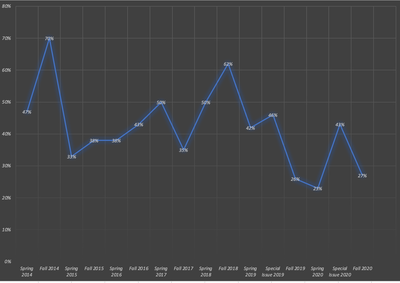CEJC in numbers: Indexing, Abstracting and the Acceptance Rate
The Spring 2021 issue has generated the highest number of submissions for “Central European Journal of Communication” history. There is also a significant change (gradual growth) in the global Scopus ranks. What’s the general tendency of CEJC’s position in Scopus database? And what’s the dynamics of CEJC’s acceptance rate?
Acceptance Rate
Since the Fall 2019 issue, we have noted the growing number of submissions for each issue of CEJC. In the case of two issues (Spring 2020 and Fall 2020) we received a total of 52 submissions, which has proven the tendency of lowering the acceptance rate (23% and 27% accordingly – see Table 1). The situation of thematic issues (Special Issues) is slightly different – they are funded by international projects on specific themes, so the chance to publish a paper in such CEJC issue is usually higher.
Table 1. CEJC Acceptance Rate in 2020

Source: CEJC.
The level of CEJC’s acceptance rate in the last years (2014–2020) varies from 70% in the Fall of 2014 to only 23% of papers accepted in the Spring of 2020 (see Figure 1).
Figure 1. The Dynamics of CEJC Acceptance Rate (2014–2020)

Source: CEJC.
Scopus (Elsevier)
“Central European Journal of Communication” is indexed and abstracted in Scopus database (since 2016). The journal holds 285th position of all the 387 global journals indexed by Scopus in the subject area of Social Science – Communication. CEJC’s position has improved Elsevier’s measures on impact and citation, namely as Source-Normalized Impact per Paper (SNIP) and CiteScore. There is also an increasing tendency inSCImago Journal Rank (SJR), which is based on the data supplied by Scopus and reflects the prestige of a journal.
Figure 2. An increasing trend of Elsevier’s measures for CEJC (2017-2019)

Source: CEJC.
See also:
CEJC in Scopus: https://www.scopus.com/sourceid/21100802697
CEJC in SCImago Journal & Country Rank: https://www.scimagojr.com/journalsearch.php?q=21100802697&tip=sid&clean=0
Michał Głowacki and Dagmara Sidyk